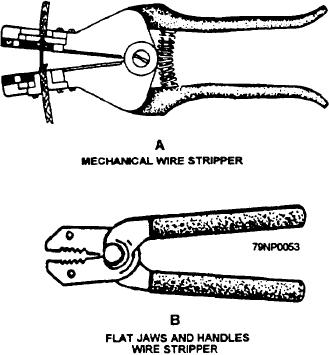
equipment in which electrical clearances would be
reduced below minimum standards require solder
terminals.
For connection under a screwhead where a
standard terminal is not practicable, you can
use an alternate method. Bare the conductor for the
required distance and thoroughly clean the strands.
Then twist the strands tightly together, bend them
around a mandrel to form a suitable size loop (or
hook where the screw is not removable), and dip the
prepared end into solder. Remove the end, remove
the excess solder, and allow it to cool before connecting
it.
After the wiring installation has been completed,
measure the insulation resistance of the wiring
circuit with a Megger or similar (0- to 100-megohm,
500-volt dc) insulation resistance measuring
instrument. Do not energize a newly installed, repaired,
or modified wiring circuit without making sure (by
insulation tests) that the circuit is free of short circuits
Figure 2-6.--Wire strippers.
and grounds.
Small refrigerators, drinking fountains, and
coffee makers are plugged into receptacles
Conductor Ends
connected directly to the ship's wiring. To
remove stress from the equipment terminal
Wire strippers (fig. 2-6) are used to strip insulation
block and its connected wiring, rigidly clamp
from the conductors. You must be careful not to nick
the cable to the frame of the equipment close
the conductor stranding while removing the insulation.
Do not use side or diagonal cutters for stripping
to the point where the cable enters the equip-
insulation from conductors.
ment.
Thoroughly clean conductor surfaces before
applying the terminals. After baring the conductor
Conductor Identification
end for a length equal to the length of the terminal
barrel, clean the individual strands thoroughly
Each terminal and connection of rotating ac and dc
and twist them tightly together. Solder them to form a
equipment, controllers, and transformers is marked with
neat, solid terminal for fitting either approved clamp
standard designations. This is done with synthetic resin
lugs or solder terminals. If the solder terminal is
tubing or fiber wire markers located as close as
used, tin the terminal barrel and clamp it tightly over
the prepared conductor (before soldering) to
practicable to equipment terminals, with fiber tags near
provide a solid mechanical joint. You do not need to
the end of each conductor, or with a stamp on the
solder conductor ends for use with solderless
terminals.
terminals applied with a crimping tool. Don't use
a side or diagonal cutter for crimping solderless
Individual conductors may also be identified
terminals.
by a system of color coding. Color coding
of individual conductors in multi conductor
Solderless terminals may be used for lighting,
cable is done according to the color coding tables
power, interior communications, and fire control
contained in Naval Ships' Technical Manual, Chapter
applications. However, equipment provided with solder
320.
terminals by the manufacturer and wiring boxes or
2-11

